NCERT Class 6 Science Chapter 10 Fun With Magnets Long Question And Answers
Question 1. Suggest an arrangement to store a U-shaped magnet. How is this different from storing a pair of bar magnets?
Answer:
It is a suggested way given below
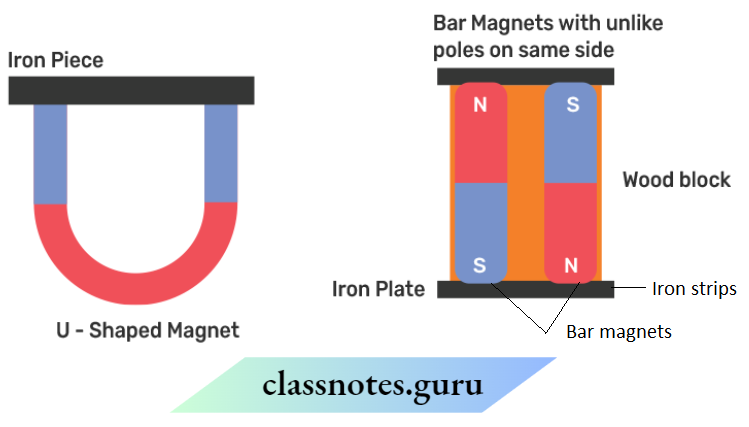
U-shaped magnet is kept along with an iron piece while bar magnets are kept in pairs with opposite poles on the same side along with iron strips and magnets separated by wood along their length.
Read and Learn More Class 6 Science Question And Answers
Question 2. A bar magnet is cut into two pieces A and B from the middle as shown in Figure

Will the two pieces act as individual magnets? Mark the poles of these two pieces. Suggest an activity to verify your answer
Answer.
Yes, two pieces will work as an individual magnet because a monopole (single pole) of a magnet never exists

Activity
- Place the magnet, so formed (A and B) on the table.
- Bring die north pole of both magnets towards each other, they will be repelled.
- Bring the north and south poles of both magnets towards each other, they will attract
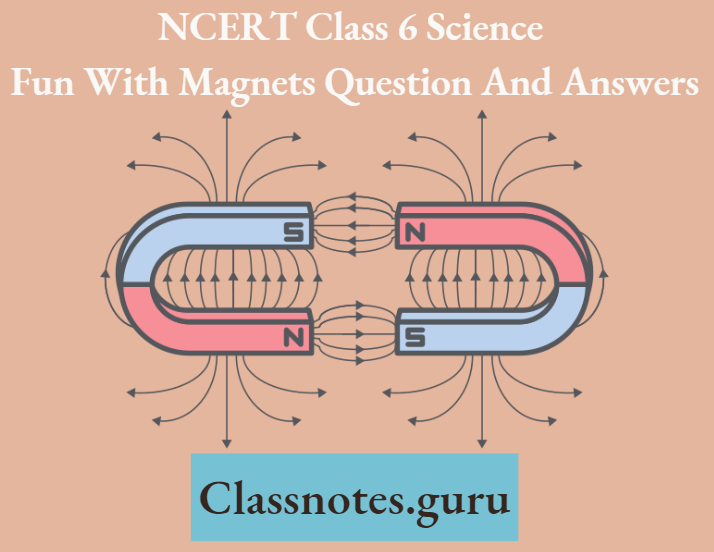
Question 3. Given below is a figure which shows a magnetic compass. Briefly explain what will happen to the position of its needle, if you bring a bar magnet near it. Also, draw a diagram to show the effect on the needle on bringing the bar magnet near it. Also, draw the diagram to show the effect when the other end of the bar magnet is brought near it.
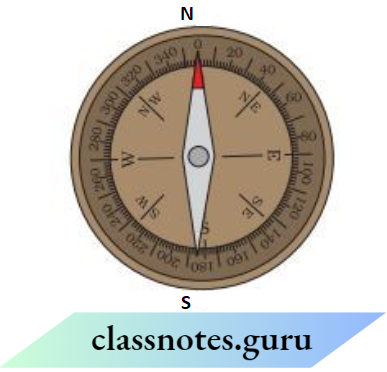
Answer:
When we bring a bar magnet near the compass, the needle of the magnetic compass starts deflecting. As the north pole of the magnet is brought closer to the compass, the south needle of the compass points towards it As the south pole of the magnet is brought closer to the compass, the north needle of a compass points towards it
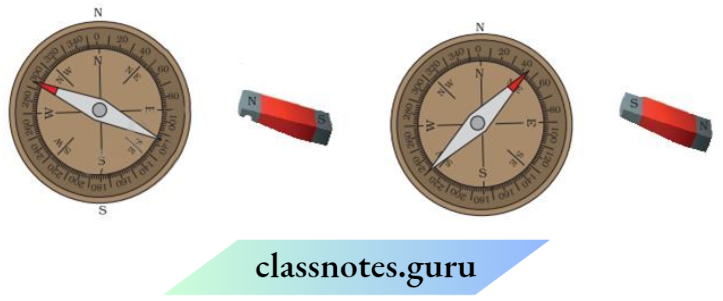
Question 4. Three identical bars are kept on a table. Two out of three bars are magnets. In one of the magnets, the north-south poles are marked. How will you find out which of the other two bars is a magnet? Identify the poles of this magnet.
Answer:
To find out the magnet
- Take the bar magnet A in your hand.
- Take the bar magnet B in the other hand.
- Bring one side of B towards the south pole and note down
- It is attracted or repelled.
- Bring the other side of B towards the south pole and again note down the same thing.
- If there is an attraction in both cases
- It is an iron bar.
- If there is an attraction in one case and repulsion in
- other cases, then it is a bar magnet
- Do the same for the iron bar C.
To find out the poles
If in case 3. the bar is attracted, then it is the north pole of the identified bar magnet. If the bar is repelled, then it is a south pole of the identified bar magnet
Question 5. A compass is an instrument which is used to find the direction and it consists of a small metal needle which is magnetised and is free to turn in any direction. It has a dial with directions marked on it. The picture shows a magnetic compass and the sun to its east. The four arrows point towards different directions
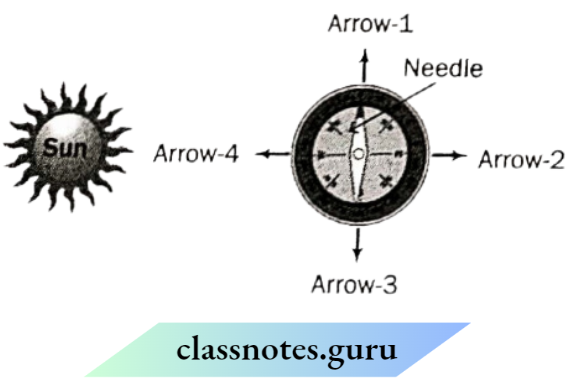
1. Which arrow is pointing towards the north?
- Arrow 1
- Arrow 2
- Arrow 3
- Arrow 4
Answer: 3. Arrow 3
Question 6. A magnetic compass is placed just beside a bar magnet. Will the compass now show direction correctly? Explain
Answer:
No, the compass will not work properly due to the interference ofthe magnetic field of the bar magnet
Question 2.


What does Sudhir’s activity show?
- Bar 1 is made of iron
- Bar 2 is made of nickel
- Bar 3 is made of silver
- Bar 4 is made of cobalt
Answer: 2. Bar 2 is made of nickel
Question 7. Sudhir repeats the activity using metal wires in the place of metal bars.

Answer:
The results will be the same as before
Question 8. Column 1 shows different positions in which one pole of a magnet is placed near that of the other. Column 2 indicates the resulting action between them for each situation.

Answer:
As we know poles of a magnet repel each other and unlike poles attract each other. Thus, the complete table is shown as below.
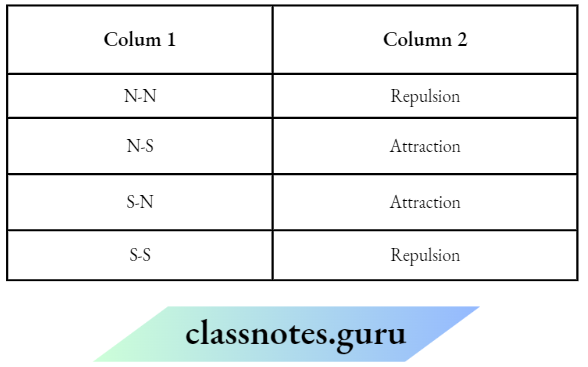
NCERT Class 6 Science Chapter 10 Fun With Magnets Short Question And Answers
Question 1. Boojho dipped a bar magnet in a heap of iron filings and pulled it out. He found that iron filings got stuck to the magnet as shown in figure

- Briefly tell the regions of the magnet that have more iron filings sticking to it.
- Mention what are these regions called.
Answer:
- Pole regions of the magnet have more iron filings sticking to it.
- These are called the North Pole and the South Pole, respectively.
Question 2. Write any two properties of a magnet.
Answer:
- The two properties of a magnet are as follows
- A magnet always has two poles, i.e. north and south.
- It attracts magnetic materials like iron, nickel or cobalt.
Question 3. Where are the poles of a bar magnet located?
Answer:
The poles of a bar magnet are located at the two ends of a bar magnet as shown below

These two poles are the north pole (N) and the south pole (S).
Question 4. A bar magnet has no markings to indicate its poles. How would you find out near which end is its north pole located?
Answer:
We can find out direction by freely suspending a bar magnet. We will find that a freely suspended bar magnet always comes to rest in the north-south direction. The end ofthe magnet that points towards the north is called a north pole. The other end that points towards the South is
called the South Pole.
Question 5. Boojho kept a magnet close to an ordinary iron bar. He observed that the iron bar attracts a pin as shown in figure

Question 6. What inference could he draw from this observation? Explain.
Answer:
When we place any iron bar near a bar magnet, it becomes a temporary magnet and small objects like pins, iron filings can be attracted by it. But when we remove this bar from magnet, it again becomes an iron bar and does not attract the small iron objects.
Question 2. Kanchan is a class 6 student. She has to show an activity in the school exhibition but she has no idea. Her friend Suresh advised her to do an activity in which rope stands without any support with the help of a magnet and asked her to take a small rope, a magnet, a cup and a stand.
- State the values that Suresh reflects here.
- Name some non-magnetic materials.
Answer:
- Suresh is a cooperative, intelligent and creative boy.
- Some non-magnetic materials are plastic, stainless steel, glass, fibre, etc.
Question 7. Explain how will you test that the ‘tea dust’ is not adulterated with iron powder.
Answer:
We can do a simple experiment for this
- Take tea dust on a piece of paper.
- Take a bar magnet in your hand.
- Shake the bar magnet over this dust.
- If some particles are attracted strongly towards this magnet, then definitely tea dust will have iron powder.
Question 8. Four identical iron bars were dipped In a heap of iron filings one by one. The figure shows the amount of Iron filings sticking to each of them.

- Which of the iron bars is likely to be the strongest magnet?
- Which of the iron bars is not a magnet? Justify your answer.
Answer:
- The iron bar seems to be the strongest magnet because it has the maximum amount of iron filings attracted.
- Iron bar Is not a magnet because no iron filings have been attracted by it.
Question 9. Explain whether the magnetic poles exist separately like charges or not.
Answer:
When we break a magnet from its middle, then we get two new magnets. Even if an extremely small magnet is broken into two pieces, then they will have north and south poles, i.e. a small bar magnet is obtained. So, the magnetic poles can’t exist separately like charges.
Question 10. Priya went to a place for her summer vacation with her sister Monami Mukherji. As the day was dark, so she couldn’t confirm that in which direction was east. Her sister had a magnetic compass and she told Priya to find the direction with the compass.
- State the values that Monami Mukherji reflect here.
- Mention what happens to a freely suspended magnet.
Answer:
- Monami is an intelligent and caring girl.
- A freely suspended magnet orients in the self north-south direction ofthe earth.
Question 11. A toy car has a bar magnet hidden inside its body along its length. Using another magnet, how will you find out which pole of the magnet is facing the front
Answer:
If we face the north pole towards the front side ofthe car and the car is attracted, it means its front side pole is the south pole and if it is going away, it means its front side is the north pole.
Question 12. State the ways through which a magnet can be demagnetised
There are two ways to demagnetise a magnet
- By heating
- By hammering
NCERT Class 6 Science Chapter 10 Very Short Question And Answers
Question 1. A tailor was stitching buttons on his shirt. The needle slipped from his hand onto the floor. How can you help the tailor to find the needle?
Answer:
We can help the tailor find the needle by using a magnet.
Question 2. You are given two identical bars which look as if they might be made of iron. One of them is a magnet, while the other is a simple iron bar. How will you find
Answer:
It can be found out by sprinkling some iron filings on both bars. Iron filings get attracted towards magnets but not towards iron bars.
Question 3. Do the materials other than magnet also come to rest in the same direction in the statue of the Emperor’s out, which one is a magnet?
Answer: No
Question 4. How can you find the direction of your classroom from the main gate of your school?
Answer:
We can find the direction of our classroom from the main gate of the school with the help of a bar magnet.
Question 5. What will happen if a magnet is brought near a compass?
Answer:
If a magnet is brought near a compass, the south pole of the compass is attracted towards the north pole of the magnet and the north pole of a compass is attracted towards the south pole of the magnet
Question 6. Give the name of a natural material that acts as a magnet.
Answer: Magnetite is the name of a natural material which acts as a magnet.
Question 7. Is the soil a magnetic or a non-magnetic material?
Answer: The soil is generally a non-magnetic material but some iron filings are available in the soil which can stick to magnets.
Question 8. Mention the name of the magnet used in the electrical bell.
Answer: The magnet which is used in electrical bell is a horse-shoe magnet.
Question 9. Paheli and her friends were decorating the class bulletin board. She dropped the box of stainless steel pins by mistake. She tried to collect the pins using a magnet. She could not succeed. What could be the reason for this? Competency Based Que.
Answer: She could not succeed because the stainless steel pins were not made of iron, so they were not attracted towards magnets.
Question 10. Name the instrument utilised in finding the direction.
Answer: The magnetic compass is the instrument used to find the direction
Question 11. In which direction, a freely suspended magnet orient itself?
Answer: A freely suspended magnet orients itselfin the north-south direction
Question 12. In which direction, does the pointed end of the needle In the magnetic compass point?
Answer: In the magnetic compass, the pointed end of the needle always points in the north-south direction.
Question 13. When the south pole of a magnet comes in contact with the south pole of another magnet, then what happens?
Answer: When the south pole of a magnet comes in contact with the south pole of the other magnet, then they repel each other because like poles always repel each other.
Question 14. Insert a magnetised needle through a paper cork. Let the cork float in the water placed in a tub in such a way that the cork does not touch the water. Does the needle always point in the same direction when the cork stops rotating?
Answer: Yes, the needle always points in the same direction when the cork stops rotating.
Question 15. Mention a way to magnetise a magnetic material with a natural magnet.
Answer: A magnetic material can be magnetised by rubbing in a particular direction.
Question 16. It was observed that a pencil sharpener gets attracted by both the poles of a magnet although its body is made of plastic. Name a material that might have been used to make some part of it.
Answer: A pencil sharpener contains a blade which is made up of iron, hence it gets attracted by both the poles of a magnet.
NCERT Class 6 Science Chapter 10 Fun With Magnets Fill In The Blanks
Question 1. A shepherd named _________________discovered the magnet.
Answer: Magnes
Question 2. Ball-ended magnet is an example of_________________magnet.
Answer: Artificial
Question 3._________________magnet is used in electric bell.
Answer: Horseshoe
Question 4. Artificial magnets have ________________shapes,
Answer: Different
Question 5. When a bar magnet is broken, each of the broken parts will have_________________pole/poles
Answer: North and south
Question 6. In a bar magnet, magnetic attraction ends.
Answer: Strong
Question 7. The south pole of Earth’s magnet is near the geographical_________________ pole.
Answer: North
Question 8. Like poles_________________ each other.
Answer: Repel
Question 9. A magnetic compass is used to find
Answer: Direction
Question 10. Hammering destroys the inside
Answer: Magnetic properties
Question 11. Magnet will lose its magnetic property, if _________________
Answer: Heated
Question 12. A freely suspended bar magnet always aligns in _________________
Answer: North-south direction
Question 13. Nickel is a_________________material.
Answer: Magnetic
Question 14. A bar magnet has the strongest magnetic field near the of the_________________ magnet
Answer: End
Question 15. Artificial magnets are made in different shapes such as____________and____________
Answer: A bar magnet, horseshoe magnet
Question 16. The materials which are attracted towards a magnet are called ____________
Answer: Magnetic materials
Question 17. Paper is not a____________material.
Answer: Magnetic
Question 18. In older days, sailors used to find direction by suspending a piece of ____________
Answer: A bar magnet
Question 19. A magnet always has ____________ poles
Answer: Two
NCERT Class 6 Science Chapter 10 Fun With Magnets True/False
State whether the following statements are true or false.
Question 1. A cylindrical magnet has only one pole.
Answer: False
Each magnet has two poles, i.e. north and south
Question 2. Artificial magnets were discovered in Greece.
Answer: False
Question 3. Similar poles of a magnet repel each other.
Answer: True
Question 4. Maximum iron filings stick in the middle of a bar magnet when it is brought near them.
Answer: False
Maximum iron filings stick up at the two ends of the magnet
Question 5. Bar magnets always point towards a north-south direction.
Answer: True
Question 6. A compass can be used to find the east-west direction at any place.
Answer: True
Question 7. Rubber is a magnetic material.
Answer: False
As rubber does not get attracted towards a magnet
Question 8. The first magnet was found in magnesia.
Answer: True
Question 9. Magnetite is an artificial magnet.
Answer: False
Question 10. The substances having the property of attracting iron are known as magnets.
Answer: True
Question 11. Lodostono Is o natural magnet.
Answer: True
Question 12. A freely suspended magnet always aligns In the north-south direction.
Answer: True
Question 13. Copper cannot be magnetised.
Answer: True
Question 14. Wooden material can be magnetised.
Answer: False
Question 15. Heating cannot destroy the magnetic properties of a magnet
Answer: False
Question 16. A bar magnet is a natural magnet.
Answer: False
Question 17. A permanent magnet is a device that retains a magnetic property without a power source.
Answer: True
Question 18. A magnetic field is a region around a magnet within which the force of magnetism acts.
Answer: True
NCERT Class 6 Science Chapter 10 Fun With Magnets Assertion-Reason Questions
The following questions consist of two statements-Assertlon (A) and Reason (R). Answer these questions by selecting the appropriate option given below
- Both A and R are true and R is the correct explanation of A.
- Both A and R are true, but R is not the correct explanation of A.
- A is true but R is false.
- A is false but R is true.
Question 1.
Assertion (A): A magnet has two poles.
Reason (R): Iron filings are highly attracted towards the poles of a magnet.
Answer: 2. Both A and R are true, but R is not the correct explanation of A.
A magnet consists of two poles i.e., the north pole and the south pole and on the poles of a magnet, the magnetic strength is strong that’s why iron filings are highly attracted towards the poles of a magnet.
Question 2.
Assertion (A): Magnets should be kept at a distance from electronic devices.
Reason (R): Electronic devices have tiny magnets inside them and magnets kept near them can damage their working
Answer: 1. Both A and R are true and R is the correct explanation of A.
Electronic devices have small magnets inside them. When an external magnet is brought near to them, it can damage their working, that’s why magnets should kept at a distance from electronic devices.
Question 3.
Assertion (A): A freely suspended magnet always aligns in the N-S direction.
Reason (R): Like poles of two magnets are always attracted towards each other.
Answer: 3. A is true but R is false.
- Magnet has some properties
- Unlike poles attract each other.
- Like poles repel each other.
- A freely suspended magnet always aligns in the N-S direction.
Question 4.
Assertion (A): A horse-shoe magnet attracts more iron filings at its poles.
Reason (R): The magnetic strength of the horse-shoe magnet is maximum at its poles.
Answer: 1. Both A and R are true and R is the correct explanation of A.
Question 5.
Assertion (A): The unknown poles of a bar magnet can be determined by suspending it freely with the help of a string.
Reason (R): A freely suspended bar magnet always comes to rest in the east-west direction.
Answer: 3. A is true but R is false.
NCERT Class 6 Science Chapter 10 Fun With Magnets Match The Columns
Question 1. Match the Column 1 with Column 2
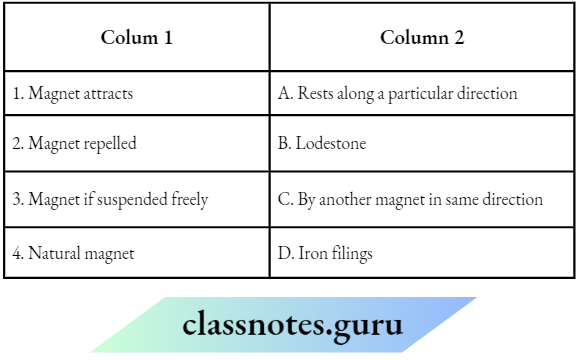
Answers: 1- D, 2-C, 3-A, 4-B
Question 2. Match the Column 1 and Column 2

Answers: 1- C, 2-A, 3-B, 4-D
Question 3. A magnet was brought from different directions towards a toy boat that has been floating in water in a tub. The effect observed in each case is stated in Column 1. Possible reasons for the observed effects are mentioned in Column 2. Match the statements given in Column 1 with those in Column 2

Answer: 1- D, 2- E, 3- 2, 4- A, 5- C
